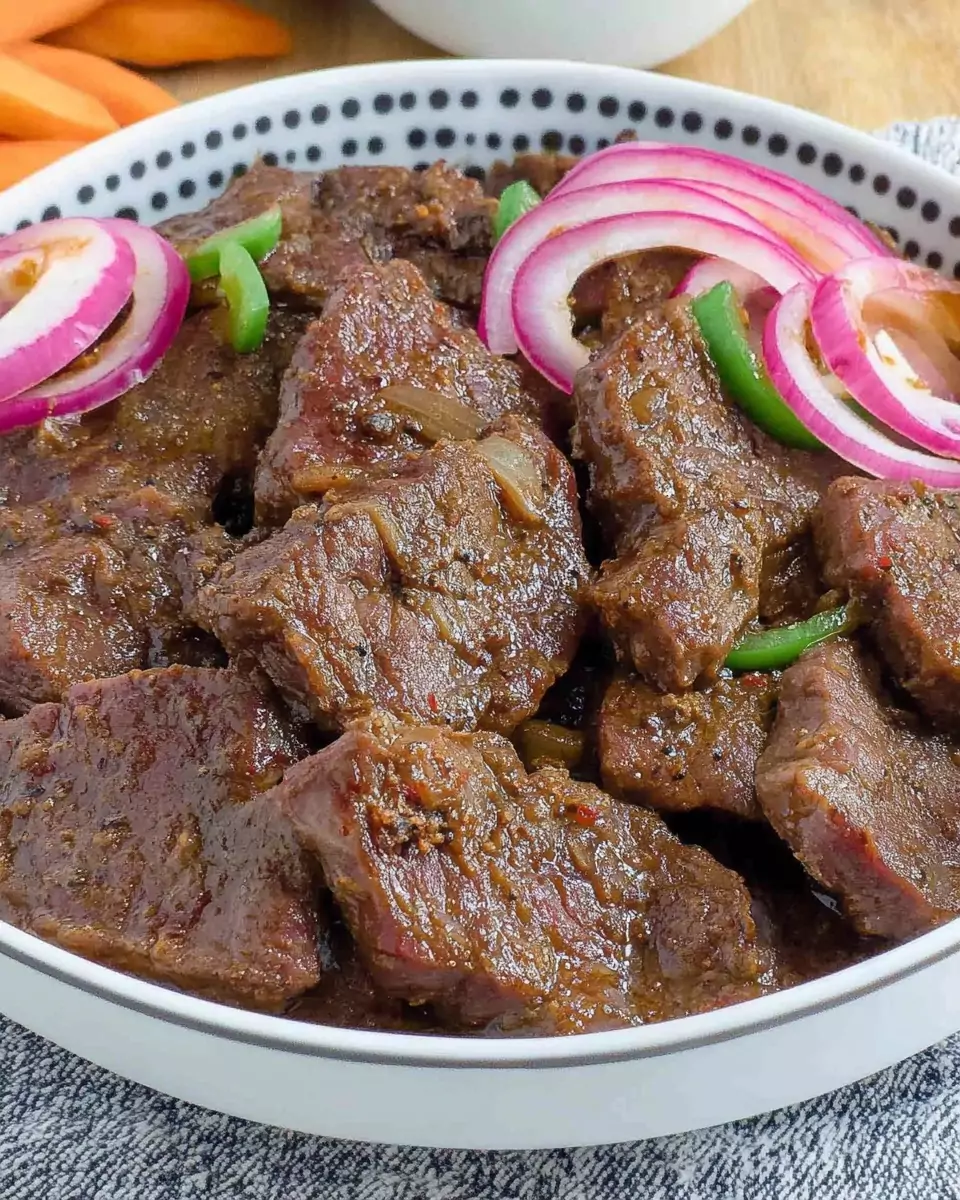Bistek Tagalog, also known as Filipino Beef Steak, is a popular Filipino dish known for its perfect combination of savory, tangy, and slightly sweet flavors. The star of this dish is the tender beef, marinated in a mixture of soy sauce, calamansi juice (or lemon), garlic, and a pinch of black pepper. The beef is then cooked until browned and simmered with onions, creating a comforting dish that is perfect for any meal. Whether you’re serving it to your family or making it for a special occasion, Bistek Tagalog offers an authentic Filipino experience right in your kitchen.

Why You’ll Love Bistek Tagalog
- Savory & Tangy Flavor: The marinated beef, combined with the calamansi or lemon, creates a delicious flavor profile that will make your taste buds dance.
- Tender and Juicy: The sirloin beef, thinly sliced and marinated, becomes incredibly tender, absorbing all the delicious flavors from the marinade.
- Easy to Prepare: Even though this dish has rich flavors, it’s easy to make with just a few key ingredients, perfect for both beginner and experienced cooks.
- Comfort Food: Bistek Tagalog is a hearty and satisfying meal, making it ideal for family dinners, gatherings, or casual meals.
Preparation Phase & Tools to Use
Essential Tools and Equipment
To ensure your Bistek Tagalog turns out perfectly, it’s important to have the right tools. Here’s a list of essential tools you’ll need:
- Large Skillet or Wok: A large skillet or wok is ideal for browning the beef and reducing the marinade into a thick sauce. The wide surface area allows the ingredients to cook evenly.
- Sharp Knife: A sharp knife is essential for slicing the beef thinly. Thin slices are key to ensuring the beef absorbs the marinade fully and becomes tender.
- Measuring Cups and Spoons: Using measuring cups and spoons will help you get the perfect balance of soy sauce, calamansi, and seasoning.
- Tongs or Spatula: These tools help you flip the beef during cooking, ensuring it doesn’t break apart and browns evenly.
- Serving Plate: A serving plate to present your Bistek Tagalog beautifully.
Importance of Each Tool
- Large Skillet or Wok: Helps achieve the perfect sear on the beef and caramelizes the onions. The high sides of a wok also help contain splatters while cooking.
- Sharp Knife: Thinly sliced beef ensures it cooks quickly and absorbs the marinade flavors better. Plus, it helps make the beef tender.
- Measuring Cups and Spoons: Precise measurements ensure the right balance of salty, tangy, and savory flavors.
- Tongs or Spatula: Ensures even cooking and prevents the beef from falling apart when flipping it.
- Serving Plate: Helps you present the dish attractively and make it more appetizing.
Preparation Tips
- Marinate the Beef Properly: Marinating the beef for at least 30 minutes helps it absorb the full flavor of the soy sauce and calamansi juice. If you have more time, marinating for up to 2 hours will bring even more depth to the flavor.
- Tenderize the Beef: For extra tender beef, you can lightly pound the thin slices with a meat mallet. This helps break down the fibers and results in a more tender bite.
- Use Fresh Calamansi or Lemon: If you can find calamansi (a small, sour citrus native to the Philippines), use it for an authentic taste. If not, lemon juice can be used as a substitute.
- Don’t Overcrowd the Pan: When cooking the beef, don’t overcrowd the skillet. This ensures that the beef can sear properly and develop a rich, brown color. Cook in batches if needed.
Ingredients (Serves 4)
- 1 lb thinly sliced sirloin
- Use sirloin for its tenderness, but you can also try other cuts like ribeye or flank steak.
- 1/4 cup soy sauce
- Soy sauce is the main seasoning for the dish and gives it its savory depth.
- 1/4 cup calamansi juice (or lemon juice)
- Calamansi adds a distinct Filipino citrus flavor. If unavailable, fresh lemon juice works as a substitute.
- 1 tablespoon garlic, minced
- Garlic is used to enhance the aroma and overall flavor profile of the dish.
- 1 teaspoon ground black pepper
- Adds a mild heat and a nice aromatic kick.
- 2 large onions, sliced into rings
- Onions are sautéed and simmered, adding sweetness and a rich texture to the dish.
- 2 tablespoons cooking oil
- Used for browning the beef and sautéing the onions.
- Salt to taste
- Adjust salt at the end of cooking, depending on the saltiness of your soy sauce.
Step-by-Step Directions
- Marinate the Beef:
In a medium bowl, mix together the soy sauce, calamansi juice (or lemon juice), garlic, and ground black pepper. Add the thinly sliced sirloin to the marinade and toss until fully coated. Let the beef marinate for at least 30 minutes. For best results, marinate it for 1-2 hours. - Cook the Beef:
Heat cooking oil in a large skillet or wok over medium-high heat. Once the oil is hot, add the marinated beef in batches to avoid overcrowding. Sear the beef for about 2-3 minutes on each side, or until browned. Remove the beef from the pan and set aside. - Sauté the Onions:
In the same skillet, add the onions and sauté them until soft and translucent, about 5 minutes. Stir occasionally to ensure the onions don’t burn and become caramelized. - Combine Ingredients:
Once the onions are soft, return the browned beef to the skillet. Pour in the remaining marinade. Stir to combine and bring the mixture to a simmer. Let it cook for 5-10 minutes, allowing the sauce to thicken and the beef to become tender. - Season to Taste:
Taste the dish and add salt as needed. Be cautious with salt since the soy sauce already adds a level of saltiness. - Serve:
Once the sauce has thickened and the beef is tender, transfer the Bistek Tagalog to a serving plate. Serve it with hot steamed rice and enjoy!
Variations:
- Add Potatoes: For a heartier dish, you can add thinly sliced potatoes to the pan after the onions are sautéed. Fry the potatoes separately, then add them in with the beef during the simmering step.
- Spicy Bistek: If you prefer a spicy kick, add sili (chili peppers) to the marinade or sauté them with the onions to infuse the dish with heat.
Serving Suggestions
Bistek Tagalog is a rich and flavorful dish that pairs wonderfully with a variety of sides. The tender beef, savory sauce, and sweet caramelized onions are best enjoyed with a neutral or complementary side that can balance the bold flavors. Here are some popular serving suggestions:
- Steamed Rice: The classic side for Bistek Tagalog. The fluffy texture of steamed rice soaks up the flavorful sauce and helps balance the savory and tangy profile of the beef.
- Garlic Fried Rice (Sinangag): If you want to elevate the dish and add a little extra flavor, try pairing Bistek Tagalog with garlic fried rice. The garlic adds a depth of flavor that complements the beef while making the dish more indulgent.
- Sautéed Vegetables: A side of sautéed kangkong (water spinach), okra, or eggplant adds a healthy contrast to the rich, savory beef. The slight bitterness of some vegetables also balances out the sweetness of the caramelized onions.
- Tomato and Onion Salad: A refreshing salad made from fresh tomatoes and onions, dressed with vinegar and salt, works as a great contrast to the savory, rich Bistek. The acidity from the salad will cut through the richness of the beef and help cleanse the palate.
- Pickled Vegetables (Atchara): Atchara, a Filipino pickle made from green papaya, carrots, and bell peppers, provides a tangy crunch that pairs well with the soft, tender beef and its savory sauce.
Common Mistakes to Avoid & How to Perfect the Recipe
When making Bistek Tagalog, there are a few common mistakes that can affect the outcome. By avoiding these pitfalls, you can ensure that your dish is flavorful and cooked perfectly every time:
1. Overcooking the Beef
- Mistake: Overcooking the beef can result in tough and dry meat. Since the beef is thinly sliced, it cooks quickly, and it’s essential to avoid leaving it in the pan for too long.
- Solution: Brown the beef quickly, 2-3 minutes on each side, and then simmer for only 5-10 minutes with the onions and marinade to allow the beef to tenderize further. This will keep the beef juicy and tender.
2. Skipping the Marinade
- Mistake: Not marinating the beef properly or for the right amount of time can lead to bland beef that lacks the deep flavor that makes Bistek Tagalog so delicious.
- Solution: Marinate the beef for at least 30 minutes. For even better flavor, marinate for 1-2 hours. The beef will absorb the soy sauce and calamansi juice, ensuring every bite is packed with flavor.
3. Not Adjusting the Seasoning
- Mistake: If you don’t taste and adjust the seasoning before serving, the dish can be either too salty or too bland.
- Solution: Always taste the dish before serving and adjust the seasoning with salt, pepper, or additional calamansi juice if needed. Different brands of soy sauce vary in saltiness, so tasting is essential.
4. Burning the Onions
- Mistake: Cooking the onions too quickly can cause them to burn instead of becoming soft and caramelized, which ruins their natural sweetness.
- Solution: Sauté the onions over medium heat and stir occasionally to prevent them from burning. They should soften and turn translucent, becoming sweet and tender as they cook.
5. Not Using Enough Sauce
- Mistake: If there’s not enough sauce, the beef can become dry, and the dish can lack flavor.
- Solution: Ensure that there is enough marinade to coat the beef and onions. As the dish simmers, the sauce should thicken but still remain present to add moisture to the beef.
Side Dish Recommendations
Here’s a list of delicious and traditional Filipino side dishes that pair wonderfully with Bistek Tagalog. These sides complement the beef’s flavor and enhance the overall meal experience.
1. Garlic Fried Rice (Sinangag)
- Description: This simple yet flavorful dish uses leftover rice fried with garlic and sometimes a hint of soy sauce or butter. The garlic and slight crispness of the fried rice makes it the perfect accompaniment to Bistek Tagalog, allowing the savory sauce to be absorbed by the rice.
- Tip: You can also add a scrambled egg to the fried rice for extra richness.
2. Pancit Canton
- Description: Pancit Canton is a stir-fried noodle dish made with egg noodles, vegetables, and sometimes shrimp or pork. It has a savory flavor with a slight sweetness and umami from the soy sauce. It pairs well with Bistek Tagalog for a hearty meal.
- Tip: Garnish with slices of lemon to add a burst of acidity, which complements the savory beef.
3. Ensaladang Mangga (Green Mango Salad)
- Description: A tangy and refreshing side dish made from green mangoes, tomatoes, onions, and a dash of shrimp paste or fish sauce. The sourness of the green mango and the saltiness of the shrimp paste balance the rich flavors of Bistek Tagalog perfectly.
- Tip: Serve chilled for an even fresher taste.
4. Sautéed Vegetables (Ginisang Gulay)
- Description: A Filipino stir-fry made with a mix of vegetables such as kangkong (water spinach), eggplant, bamboo shoots, and string beans, sautéed with garlic and onions. The slight bitterness of the vegetables provides a nice contrast to the savory, rich Bistek.
- Tip: You can add a little fish sauce or soy sauce to season the vegetables for an extra depth of flavor.
5. Laing (Taro Leaves in Coconut Milk)
- Description: Laing is a creamy dish made with taro leaves, cooked in rich coconut milk, and flavored with chili peppers. The creamy coconut milk and mild heat from the chili provide a perfect contrast to the savory beef in Bistek Tagalog.
- Tip: Add more chili if you want extra heat or leave it mild for a more soothing pairing.
6. Baked Sweet Potatoes
- Description: Roasted or baked sweet potatoes add a natural sweetness to the meal. Their soft texture and flavor make them a great counterpoint to the tangy Bistek sauce.
- Tip: Slice the sweet potatoes into wedges, season lightly with salt, and bake until golden brown.
7. Tomato and Onion Salad
- Description: A light salad made with fresh tomatoes and onions, seasoned with salt, pepper, and vinegar. It’s simple, refreshing, and provides a bright acidity that contrasts with the richness of the beef.
- Tip: You can add a pinch of sugar to balance the acidity of the vinegar.
8. Atchara (Pickled Papaya)
- Description: A Filipino pickle made from green papaya, carrots, and bell peppers. It adds a crunchy, sweet, and tangy flavor that cuts through the rich beef stew.
- Tip: Make it ahead of time as the flavors improve after a day or two of marinating.
With these side dishes, you’ll create a complete and satisfying Filipino meal that everyone will love. Whether you stick to traditional sides like Sinangag or get adventurous with dishes like Laing, these accompaniments will perfectly complement the flavors of your Bistek Tagalog.
Recipe Tips
To ensure that your Bistek Tagalog turns out as delicious as possible, here are some helpful tips:
- Use Thinly Sliced Beef: For the best results, use thin slices of beef such as sirloin, flank steak, or ribeye. Thin slices cook quickly and absorb the marinade more effectively, resulting in a tender, flavorful dish.
- Marinate Longer for More Flavor: While 30 minutes is the minimum time needed to marinate, marinating the beef for up to 2 hours will allow the meat to fully absorb the soy sauce, calamansi (or lemon), and garlic flavors. This makes the beef more flavorful and tender.
- Control the Sauce Consistency: If you prefer a thicker sauce, let it simmer longer to reduce. On the other hand, if you prefer more sauce, add a little water or beef broth during the simmering process to ensure you have enough liquid to coat the beef and onions.
- Adjust the Tanginess: If you love a stronger tangy flavor, feel free to add more calamansi or lemon juice to the marinade. If you prefer a milder flavor, you can reduce the amount of citrus.
- Customize the Spice Level: For those who love spice, add fresh chili peppers or chili flakes into the marinade or sauté them with the onions. This will bring an extra layer of heat to balance the sweetness and tanginess of the dish.
- Ensure Proper Searing: Searing the beef on both sides before simmering ensures that the beef locks in its juices and becomes extra tender. Don’t skip this step! Browning adds depth to the flavor of the dish.
- Rest the Dish Before Serving: Let your Bistek Tagalog rest for a few minutes after cooking. This allows the beef to settle and ensures the flavors meld perfectly before serving.
Storage and Reheating Instructions
Bistek Tagalog makes for excellent leftovers, and with the right storage and reheating methods, it can taste just as good the next day.
Storage:
- Cool Before Storing: Allow the dish to cool to room temperature before placing it in the refrigerator. This prevents condensation and ensures that the dish maintains its texture.
- Store in an Airtight Container: Transfer the Bistek Tagalog into an airtight container to keep it fresh for longer. It will stay good for up to 3-4 days in the refrigerator.
- Freezing: If you want to store the dish for a longer period, you can freeze it. Ensure that the dish is in a freezer-safe container and that it is well-sealed. It can be frozen for up to 1-2 months.
Reheating:
- Stovetop: The best way to reheat Bistek Tagalog is on the stovetop. Place it in a skillet over low-medium heat, adding a splash of water or broth to keep it from drying out. Stir occasionally until it is heated through.
- Microwave: You can also reheat Bistek in the microwave. Place it in a microwave-safe container, cover it loosely, and heat it on medium power for 2-3 minutes, stirring halfway through. Make sure to check the temperature before serving.
- Avoid Overheating: Reheat the dish just enough to warm it up; overcooking can make the beef tough again.
FAQs
Here are some frequently asked questions about Bistek Tagalog:
1. Can I use other types of beef for Bistek Tagalog?
- Yes! While sirloin is commonly used for Bistek Tagalog, you can also try other tender cuts like ribeye or flank steak. Just make sure the beef is thinly sliced to ensure it cooks quickly and absorbs the flavors of the marinade.
2. What if I can’t find calamansi?
- If calamansi is unavailable, you can substitute it with fresh lemon or lime juice. While it may not have the exact flavor of calamansi, lemon or lime still provides the necessary tanginess.
3. How do I know when the beef is tender enough?
- The beef should be tender after simmering in the sauce for about 10 minutes. If it’s still tough, continue simmering it for another 5-10 minutes until it softens to your liking. The thinness of the beef should ensure it cooks quickly and becomes tender.
4. Can I add other vegetables to the Bistek Tagalog?
- Absolutely! You can add bell peppers, potatoes, or even mushrooms for a twist on the classic recipe. Just sauté them with the onions or add them into the simmering pan with the beef for extra flavor and texture.
5. Is Bistek Tagalog served with anything other than rice?
- While steamed rice is the most common side, Bistek Tagalog can also be paired with garlic fried rice, pancit, or even pickled vegetables (atchara) for added contrast.
6. How do I make Bistek Tagalog spicier?
- For a spicy version, add fresh chili peppers to the sautéed onions or mix chili flakes into the marinade. Adjust the level of heat according to your preference!
Conclusion
Bistek Tagalog is a beloved Filipino dish that brings together a wonderful balance of savory, tangy, and slightly sweet flavors. With its tender beef and aromatic marinade, it’s no wonder that it’s a staple in Filipino households and an absolute crowd-pleaser. By following the recipe tips and pairing it with the right sides, you can recreate an authentic Filipino experience right in your kitchen.



Leave a Comment